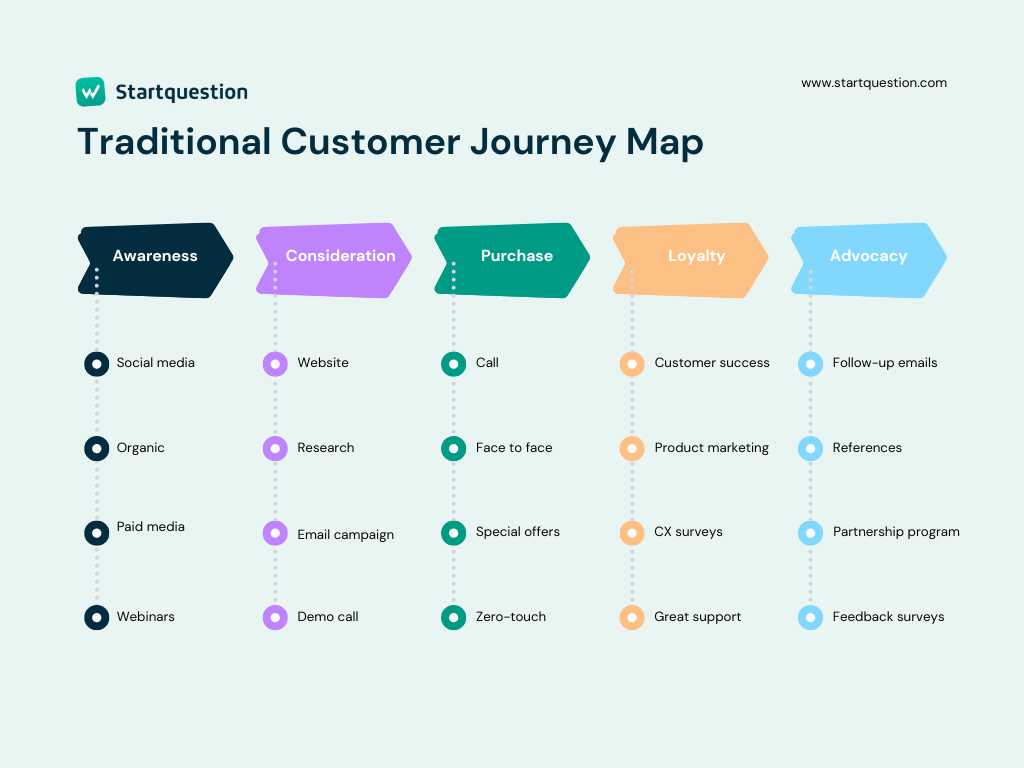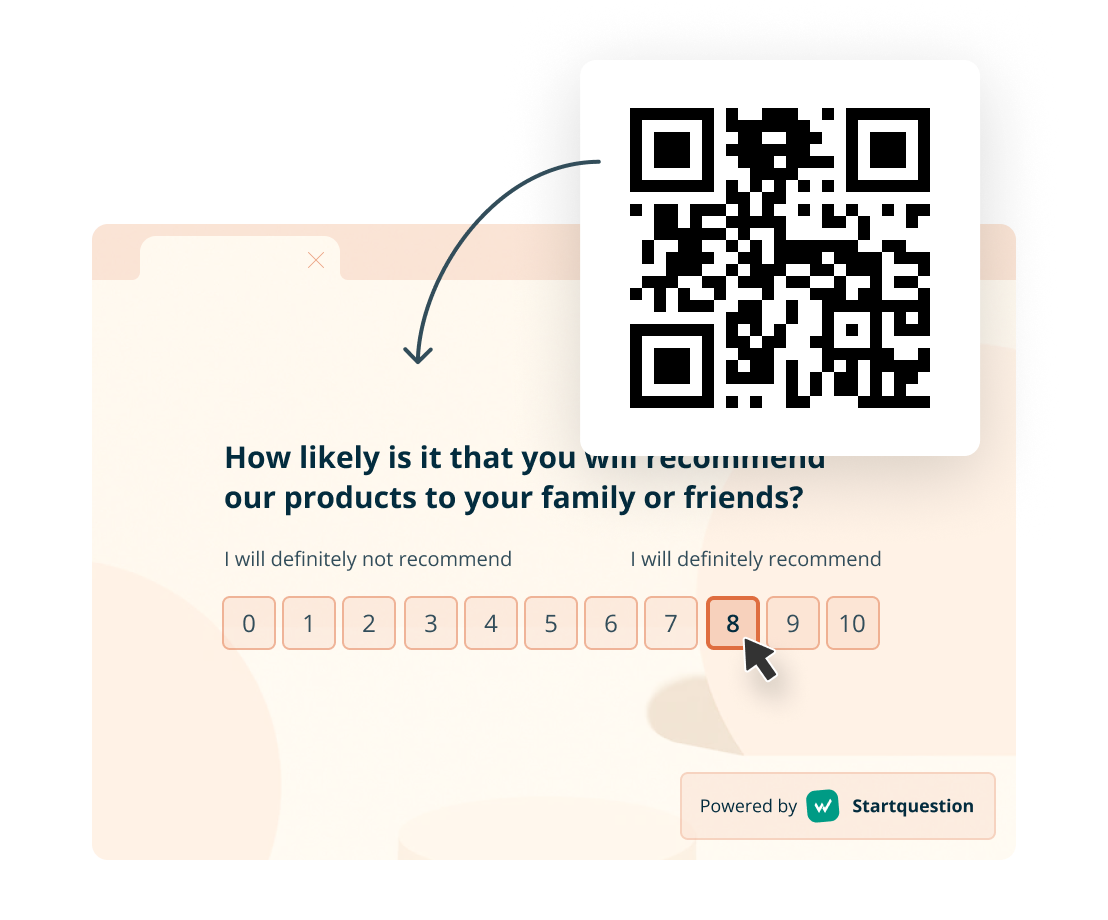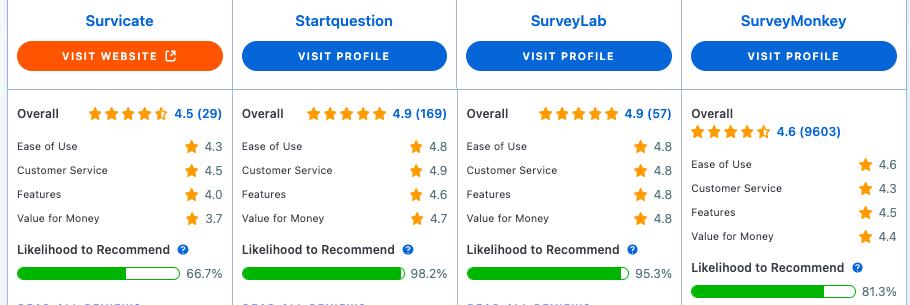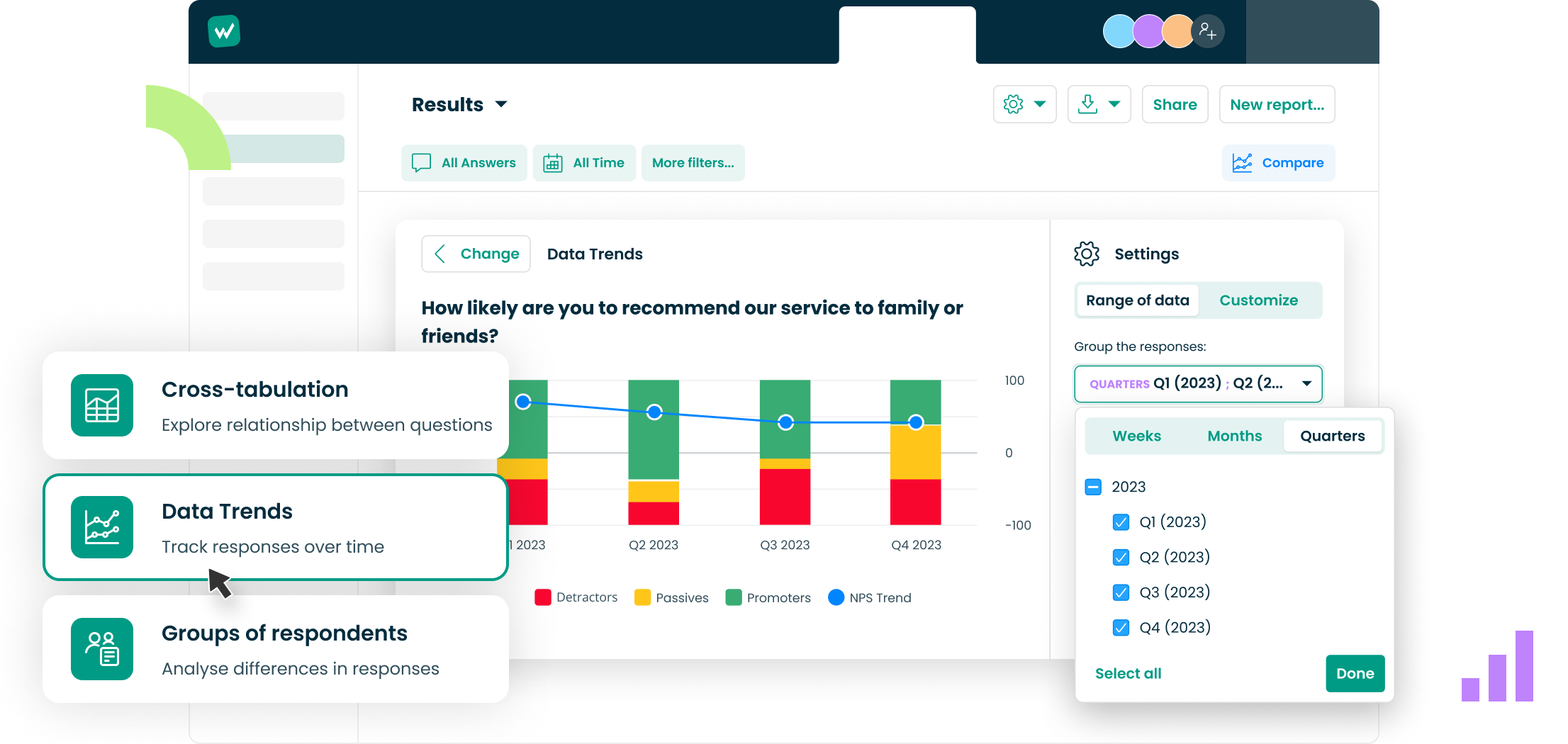Understanding your customers’ experiences can elevate your business from good to great. Customer journey mapping, a powerful visual tool, uncovers every interaction customers have with your brand, highlighting pain points and opportunities for improvement. Recent data reveals that companies using these maps see a 54% increase in marketing ROI and a 90% drop in complaints. These insights enhance customer satisfaction and loyalty, align your teams, and personalize interactions, driving growth and success in previously unimagined ways.
Discover how journey mapping can transform your business.
What Is a Customer Journey Map? [Definition]
A customer journey map is a valuable strategic tool for visualizing and comprehending a customer’s complete experience with a brand, product, or service. It aims to document the customer’s interactions from initial awareness to post-purchase, emphasizing crucial touchpoints and emotions. Businesses can effectively identify pain points, optimize customer experiences, and enhance overall satisfaction through this mapping process.
How Customer Journey Map Can Help Your Business?
Do you need to develop a customer journey map template for your organization? Well, it depends. Before deciding, see if you can enjoy the benefits of the effectiveness of mapping a customer’s journey.
Boosting Return on Investment (ROI)
An analysis of customer journeys has demonstrated an average 54% increase in return on investment (ROI) from marketing activities. This significant improvement is mainly attributed to a better comprehension of customer behavior and needs, enabling businesses to effectively target their efforts and minimize resource wastage (Spiralytics).

Improving Customer Retention Rate
Businesses that use customer journey maps to understand better customer interactions and emotions often see higher customer retention rates and increased customer satisfaction. Companies can build stronger loyalty and encourage repeat business by addressing specific pain points and improving critical touchpoints (Outwitly).
View the Experience from the Customer’s Perspective
Creating a customer journey map enables businesses to understand their products and services from their customer’s perspective. This insight helps identify areas for enhancing the customer experience, ensuring smooth and enjoyable interactions. Understanding the customer’s viewpoint is crucial for developing a user-centric approach that meets their needs and expectations.
Identify Gaps in Service or Communications
Mapping the customer journey effectively can enhance customer support by pinpointing common problem areas. It enables businesses to proactively resolve issues, improve resource allocation, and streamline processes for quicker and more efficient solutions, increasing customer satisfaction (User Journey Map).
Reduction of customer complaints by 90%
Companies that use mapping to identify customer touchpoints report a 90% decrease in customer complaints. This significant reduction is due to identifying and resolving pain points and gaps in the customer experience, leading to higher satisfaction and fewer issues (Hotjar).
Narrowing down Your Potential Customer Base
Mapping the customer journey helps businesses identify their ideal customers and tailor their strategies accordingly. By understanding different customer segments’ specific needs and behaviors, companies can focus their efforts on the most promising prospects. This targeted approach improves marketing efficiency and increases the likelihood of attracting and retaining customers.
Creating Customer-Focused Mentality throughout the Company
A customer journey map helps create a customer-focused culture in an organization. Picturing the customer experience, all departments can understand how their actions affect it. This shared understanding encourages teamwork and working together towards common goals, ensuring every team member focuses on improving the customer experience.
Adaptation of Cross-Functional Teams
Customer journey mapping helps different departments in a company work better together. It makes sure everyone understands the customer experience. This way, teams like marketing, sales, and customer service can work well towards shared goals. It reduces barriers between departments and makes the customer experience more consistent and smooth (Hotjar).

The Customer Journey Mapping Process
Creating a customer journey map is essential as it visually represents customers’ interactions with a company. This process includes gathering and organizing data about customers’ various stages and creating a visual map of their journey.
The goal is to gain insights that improve the understanding of customer experiences and identify potential obstacles. It’s important to understand that most customer journeys are complex. Buyers often experience cyclical, repetitive, and multi-channel journeys.
Now, let’s look at the stages that should be included in each of customer journey map templates.
Buying Decision Process
Creating your customer journey mapping template begins with understanding the buying decision process. This stage involves detailing each step a customer takes, from recognizing a need or problem to making a purchase decision. Here are the key stages:
- Awareness: Customers know a product or service that might solve their problem.
- Consideration: Customers research and evaluate different options.
- Decision-Making: Customers choose a product or service based on their evaluation.
Mapping these steps is a crucial tool for businesses to understand how customers move through the funnel and what influences their decisions. It provides a clear picture of customer behavior, enabling businesses to make informed decisions.
Discovering Customer Emotions
Understanding customer emotions is crucial for creating a practical customer journey map. This involves capturing how customers feel at each touchpoint of their journey. Customer experience (CX) surveys are a valuable tool in this process. These surveys can gather qualitative data on customer satisfaction, frustration (customer churn), delight, and other emotions experienced throughout their interactions with the company. Popular CX surveys include:
- Net Promoter Score (NPS): Measures customer loyalty and likelihood to recommend the company to others.
- Customer Satisfaction Score (CSAT): Assesses customer satisfaction with specific interactions or overall experience.
- Customer Effort Score (CES): Evaluates how easy it is for customers to resolve their issues or achieve their goals.
Questions in CX surveys include asking customers to rate their satisfaction with specific interactions, describe their feelings during critical moments, and provide open-ended feedback about their overall experience. Analyzing this emotional data helps businesses identify areas where customers experience emotional highs and lows, which can be addressed to improve the overall customer experience.
Gathering User Actions
The next step in the customer journey mapping process is gathering detailed information on user actions. This involves tracking customers’ actions during their journey, from initial contact through to post-purchase interactions. Data can be collected through various means, such as web analytics, transaction records, customer feedback, and direct observation. Key user actions might include:
- Visiting the website
- Interacting with customer service
- Making a purchase
- Engaging with follow-up communications
By mapping these actions, businesses can visualize the sequence of customer steps and identify critical touchpoints that significantly impact the customer experience.
Analyzing and Identifying Gaps
Once the user actions and emotions are mapped, the next step is to analyze the data to identify gaps in the customer journey. This involves looking for points where the customer experience breaks down or fails to meet expectations. Common gaps might include:
- Unclear information
- Slow response times
- Technical issues
- Inconsistent service across different channels
Tools like customer feedback analysis, usability testing, and process audits can help identify these gaps. By understanding where and why these issues occur, businesses can prioritize areas that need improvement, offering a promising opportunity to enhance the overall customer journey.
Implementing Improvements
The final step in the customer journey mapping process is implementing improvements based on the insights gained from the analysis. This involves developing an action plan to address identified gaps and enhance the customer experience at critical touchpoints. Improvements might include:
- Streamlining the checkout process
- Enhancing customer support
- Personalizing marketing communications
- Optimizing website usability
It is essential to continuously monitor the impact of these changes through ongoing customer feedback and performance metrics to ensure they effectively address customer pain points and lead to a better overall experience. Regular updates and refinements to the customer journey map ensure it remains relevant and aligned with evolving customer expectations.
Customer Journey Map Examples
A customer journey map helps companies from different industries understand and optimize the customer experience by identifying key touchpoints and potential pain points. Below are the characteristics of various customer journey mapping examples:
B2B Customer Journey Map
A B2B (Business-to-Business) customer journey map is designed to capture the complexities of business interactions. Due to the multiple stakeholders involved in the decision-making process, these journeys are often longer and more intricate than those in B2C (Business-to-Consumer) contexts. Characteristics of a B2B customer journey map include:
Extended Decision-Making Process:
The journey often involves several stages: initial contact, needs assessment, proposal evaluation, negotiation, purchase decision, and post-purchase support.
Multiple Touchpoints:
It includes interactions such as meetings, phone calls, emails, product demonstrations, and site visits.
Stakeholder Involvement:
Multiple individuals from different departments (e.g., procurement, finance, end-users) participate in the journey, requiring a comprehensive approach to address varied needs and concerns.
Focus on Relationship Building:
The map emphasizes building long-term relationships, highlighting trust-building activities, continuous engagement, and account management.
Complex Buying Criteria:
Factors like return on investment (ROI), scalability, and compliance with industry standards play a significant role in decision-making.

E-commerce Customer Journey Map
An e-commerce customer journey map tracks the online shopping experience of customers from discovery to purchase and beyond. This map type is essential for optimizing digital interactions and improving conversion rates. Key characteristics include:
Digital Touchpoints:
The journey primarily occurs online, involving website visits, social media interactions, email communications, and online advertisements.
Shorter Decision Cycles:
Compared to B2B, the decision-making process in e-commerce is often quicker, with immediate actions like adding items to the cart, checking out, and post-purchase feedback.
Emphasis on User Experience (UX):
Smooth navigation, fast loading times, mobile responsiveness, and secure payment options are critical factors that influence customer satisfaction.
Personalization:
Tailoring recommendations, offers, and communications based on customer behavior and preferences to enhance the shopping experience.
Post-Purchase Engagement:
Includes follow-up emails, delivery tracking, customer support, and encouraging product reviews to maintain engagement and foster loyalty.
Retail Customer Journey Map
A retail customer journey map outlines the in-store shopping experience, integrating physical and digital elements to reflect the modern omnichannel retail environment. Important characteristics include:
Combination of Online and Offline Touchpoints:
The journey often begins online with activities like browsing the website or app continues in-store with physical interactions and may conclude with digital follow-ups.
In-Store Experience:
Critical touchpoints include store layout, product availability, staff interactions, checkout process, and in-store promotions.
Seamless Omnichannel Integration:
The journey emphasizes a cohesive experience across various channels, ensuring consistency whether the customer shops online, in-store, or combines both.
Personalized Customer Service:
Tailoring in-store assistance and recommendations based on customer history and preferences collected from loyalty programs or prior interactions.
Focus on Immediate Gratification:
Unlike e-commerce, the retail journey often caters to customers seeking instant satisfaction, making inventory management and efficient checkout processes vital.

Drive Customer Success with Pro Tools
Creating a customer journey map involves understanding how customers make buying decisions, capturing their feelings at each interaction, studying data to find areas for improvement, and making targeted enhancements based on the analysis.
Conduct Customer Surveys to Gather Feedback
Online survey software tools such as Startquestion can help gather and respond to customer feedback effectively. Why it’s so important? Because it’s the continuous tracking of changes and regular updates to the customer journey map that are the real game-changers. These are essential to keep the map relevant and ensure ongoing improvement. This systematic approach can help businesses improve customer journeys, increasing satisfaction and loyalty.
We’ll be delighted to assist you with the process.










